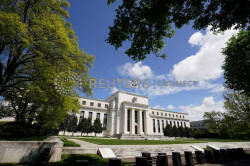Column: Central banks left flat-footed by flexible Fed - Mike Dolan
 Send a link to a friend
Send a link to a friend
 [March 24, 2021] By
Mike Dolan [March 24, 2021] By
Mike Dolan
LONDON (Reuters) - This time it is probably
different - or at least for monetary policymakers and markets trying to
track them.
Fuzzier Federal Reserve targets are creating a fog for other central
banks and for investors gauging the next upswing in the interest rate
cycle over the coming years.
The new average inflation regime hasn't been tried before and only the
Fed has formally adopted it so far - leaving considerable uncertainty
over how the Fed itself will behave, and also over how other countries
react to a new mandate in Washington while they still observe the old
ones.
Desired or not, the dollar's still-dominant role in world finance means
the Fed's trajectory remains as critical as ever for countries'
financial policy and planning - especially in emerging markets, but in
developed economies too.
Last year's strategic review of its inflation goals gave the Fed
substantial room for manoeuvre over when exactly to act on rising
inflation.

As it's no longer strictly bound to tighten credit when inflation is set
to exceed the 2% target, due to a new long-term averaging of that goal,
it can - and plans to - run the economy 'hot' as long as it deems the
coming inflation spike temporary.
It stressed that again over the past week - saying the majority of its
policymakers still saw no rate tightening before 2024 - and indicated it
would not change its stance without clear evidence of a shift in
long-term inflation or employment developments rather than the mere
forecasts of such.
GRAPHIC: The Fed keys on inflation expectations -
https://graphics.reuters.com/USA-FED/INFLATION/
bdwvkmkodvm/chart.png
All that may make sense for today's America - but it's still from far
clear how it plays out for the rest of the world.
When it was rolled out last year in the middle of the pandemic, many
assumed the change would simply lead to easier money for longer and a
weaker dollar to match.
That has its own overseas strains - but arguably more easily managed by
emerging market central banks that can lean against exchange rate
strength, build hard cash reserves and keep finance stable.
But the initial thinking didn't quite capture the scale of the
subsequent U.S. fiscal boost and the resulting rise in real bond yields
this year that has confounded consensus and strengthened the dollar
steadily.
This seriously complicates the U.S. view, first and foremost.
Not having played this particular game before, financial markets have in
effect been left to make up their own minds. And their assessment to
date, correct or not, is that the Fed will blink earlier and raise rates
as soon as next year - sending real-inflation adjusted bond yields
climbing as a result.
Siding with the hawkish fringe of the Fed council, futures pricing
appears to see such loose fiscal policy leading to rapid growth,
re-employment and inflation that allow the Fed to start 'normalising'
much sooner than it's currently indicating.
"It's an outcome-based test," claimed Dallas Fed chief Robert Kaplan on
Tuesday, adding he was one of the policymakers expecting a rate rise
next year.
[to top of second column] |

The Federal Reserve building is set against a blue sky in
Washington, U.S., May 1, 2020. REUTERS/Kevin Lamarque/File Photo

FOGGY DUES
But that foggy view makes a mess of the outlook for central banks adjusting to
the inevitable overspill of U.S. conditions - with a sudden, dramatic reversal
of investor flows to emerging markets this month triggered by a spike in
Treasury yields.
Within a week of those outflows, Brazil, Russia and Turkish central banks rushed
to jack up interest rates in the throes of a pandemic in order to head off
currency weakness - with the scale of Turkey's tightening enough to see its
central bank boss ousted at the weekend and the lira in tailspin again anyhow.
GRAPHIC: Emerging Market currencies through the pandemic -
https://fingfx.thomsonreuters.com/
gfx/mkt/qzjpqlozmvx/EMFX.PNG
"Investors didn't give up their bullish emerging market view until U.S.
(10-year) Treasuries hit 1.6%," Morgan Stanley's EM team observed. "But the
spike in USTs was a wake-up call to everyone and investors have become more
cautious on EM since."
But this second-guessing of the gradual evolution in Fed thinking is not solely
an emerging market problem.
The spike in U.S. real yields spilled over to Europe too, where a third wave of
the pandemic is still in full swing and lockdowns still tightening. And this
already forced the European Central Bank to step up its bond buying programme -
less sure that euro zone fiscal spending will come close to Washington's.
But at least the ECB already looks set fair to follow the Fed's strategy rethink
toward more flexible inflation targets.

The Bank of England is still theoretically bound by its government-mandated 2%
point target for inflation and its chief economist and others are already
chomping at the hawkish bit.
Despite a dire year for the British economy and the trade sensitivity of any
outsize sterling strength, futures markets see the BoE lifting rates before the
Fed - partly because of its now stricter mandate during a reflationary period.
GRAPHIC: G4 Policy Interest Rates -
https://fingfx.thomsonreuters.com/
gfx/mkt/nmopardarva/G4.PNG
"There is a genuine worry around persistent excess inflation for some in the
internal camp within the (BoE) and we think this will continue to play out over
the next several months, especially given the Bank’s symmetric inflation
target," Deutsche Bank economist Sanjay Raja said.
Offsetting factors include tighter UK fiscal projections that may allow the BoE
to hang loose for longer, Raja said.
"The bar for the BoE to tighten policy over the next two to three years may be
high, though not entirely insurmountable."
GRAPHIC: Emerging Market CDS rates over 12 years -
https://fingfx.thomsonreuters.com/
gfx/mkt/bdwvkmlbqvm/EMCDS.PNG
(The author is editor-at-large for finance and markets at Reuters News. Any
views expressed here are his own)
(by Mike Dolan, Twitter: @reutersMikeD; editing by John Stonestreet)
[© 2021 Thomson Reuters. All rights
reserved.] Copyright 2021 Reuters. All rights reserved. This material may not be published,
broadcast, rewritten or redistributed.
Thompson Reuters is solely responsible for this content. |